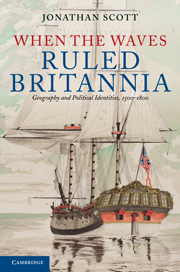Book contents
- Frontmatter
- Contents
- List of figures
- List of maps
- Preface: Geography and the sea
- List of abbreviations
- Introduction: Britain's island idea
- 1 Community of water
- 2 Queen of Sparta
- 3 The discipline of the sea
- 4 Ark of war
- 5 Blowing a dead coal
- 6 The British empire in Europe
- 7 The world in an island
- 8 Anti-continentalism
- 9 What continent?
- Conclusion: floating islands
- Appendix: Duck Language (1724)
- Bibliography
- Index
3 - The discipline of the sea
Published online by Cambridge University Press: 05 June 2012
- Frontmatter
- Contents
- List of figures
- List of maps
- Preface: Geography and the sea
- List of abbreviations
- Introduction: Britain's island idea
- 1 Community of water
- 2 Queen of Sparta
- 3 The discipline of the sea
- 4 Ark of war
- 5 Blowing a dead coal
- 6 The British empire in Europe
- 7 The world in an island
- 8 Anti-continentalism
- 9 What continent?
- Conclusion: floating islands
- Appendix: Duck Language (1724)
- Bibliography
- Index
Summary
Yet thy brave beames excluded from their right
Maintaine there Lustre still, & shining cleere
Turne watrish Holland to a crystalline sphere.
Mee thinkes, in that Dutch optick I doe see
Thy curious vertues much more visibly:
There is thy best Throne. For afflictions are
A foile to sett of worth, & make it rare.
George Herbert, To the Queene of BohemiaA Scottish king, coming also to wear the English crown, established claim to a British dynasty, if not a single island kingdom. The first and most important ambition of King James VI and I was to turn this dynastic into a political (and religious) union: a melding of nations which would be not only insular but archipelagic, the Anglo-Scottish planting of Ireland one of its instruments. Writing later, Thomas Hobbes credited that ‘most wise King’ with pursuing a Roman strategy of incorporation ‘Which if he could have obtained, had in all likelihood prevented the Civill warres, which make both those Kingdomes, at this present, miserable’.
That neither James nor his son Charles obtained this end resulted not only from the great cultural, religious and political differences to be overcome, but from the growing discrepancy between the ambitions and jurisdictions, and the actual military and political power, of the crown. Both of these problems were to be dramatically exacerbated by the European military conflict of 1618–48, of which the wars of the three Stuart kingdoms became one theatre.
- Type
- Chapter
- Information
- When the Waves Ruled BritanniaGeography and Political Identities, 1500–1800, pp. 54 - 72Publisher: Cambridge University PressPrint publication year: 2011



